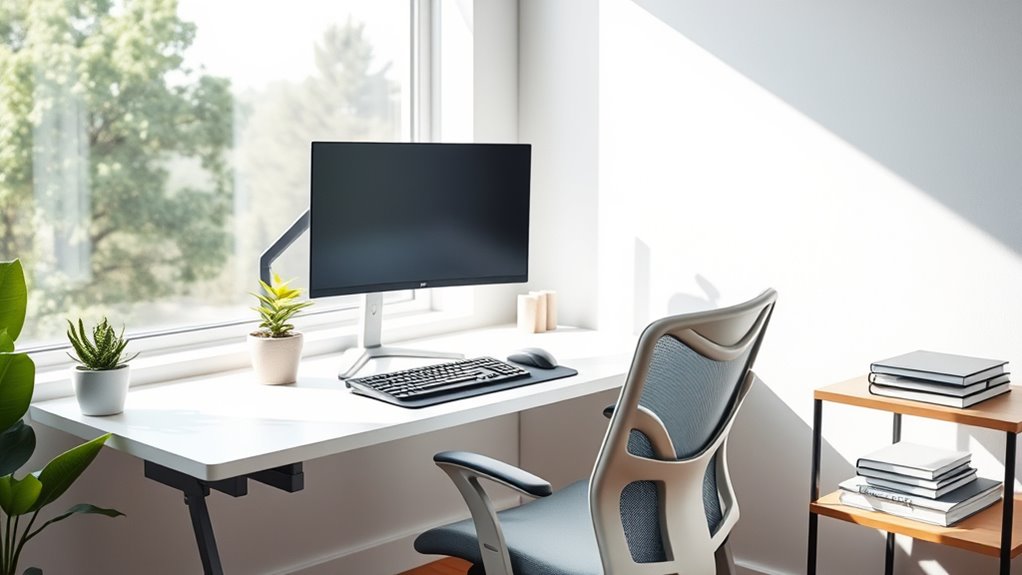To set up an ergonomic home office, make certain your desk height allows your forearms to be parallel to the floor and keep essentials within easy reach. Adjust your chair for proper lumbar support, with feet flat on the ground and arms relaxed. Position your monitor at eye level about an arm’s length away, minimizing glare. Incorporate natural lighting, take regular breaks, and stay mindful of your posture to boost comfort and productivity as you continue exploring more tips.
Key Takeaways
- Adjust your desk and chair so forearms are parallel to the floor and feet rest flat on the ground.
- Position your monitor at eye level, about an arm’s length away, directly in front of you.
- Keep frequently used items within easy reach to minimize stretching and twisting.
- Ensure proper lighting to reduce glare and eye strain, using natural or soft artificial light.
- Take regular breaks every 30 minutes to stand, stretch, and promote circulation.

Setting up an ergonomic home office is essential for staying comfortable and productive throughout your workday. One of the most fundamental aspects is paying attention to desk ergonomics. Your desk should be at a height that allows your forearms to be parallel to the floor when typing, preventing strain on your shoulders and wrists. Avoid desks that are too high or too low, as they can cause awkward postures and discomfort over time. Guarantee there’s enough space on your desk for your monitor, keyboard, mouse, and any other essentials, keeping everything within easy reach to minimize unnecessary stretching or twisting.
Equally important are chair adjustments. Your chair should support your lower back, promoting proper spinal alignment. Adjust the height so that your feet rest flat on the floor, with your knees at a 90-degree angle. If your feet don’t reach the ground comfortably, consider using a footrest. The chair’s armrests should be set so your shoulders stay relaxed, and your elbows rest comfortably at your sides. Proper chair adjustments help prevent tension buildup in your neck, shoulders, and back, making it easier to stay focused and comfortable during long work sessions.
Positioning your monitor is also crucial. Keep the top of your screen at eye level, about an arm’s length away from your face. This setup prevents you from tilting your head up or down, which can lead to neck strain. If you use a laptop, consider investing in a stand or external monitor to achieve the correct height, and use a separate keyboard and mouse to maintain proper ergonomics. When setting up your workspace, make sure your monitor is directly in front of you, avoiding any twist or turn of your neck.
Lighting plays a vital role in your ergonomic setup. Aim for natural light or soft, evenly distributed artificial lighting to reduce eye strain. Position your monitor to avoid glare from windows or lamps. Keep frequently used items within arm’s reach so you don’t have to stretch or twist to grab them, which can compromise your posture. Incorporating sound therapy elements, such as background music or white noise, can also help improve focus and reduce stress during work hours.
Finally, incorporate movement into your routine. Even with the best desk ergonomics and chair adjustments, staying in the same position for extended periods isn’t healthy. Take short breaks to stand, stretch, or walk around every 30 minutes. This helps maintain circulation, reduces muscle tension, and keeps you alert. By paying close attention to these ergonomic details—desk ergonomics, chair adjustments, and overall workspace setup—you’ll create a comfortable, efficient environment that supports your health and productivity every workday.
Frequently Asked Questions
How Do I Adjust My Chair for Optimal Comfort?
To adjust your chair for maximum comfort, start by setting the seat height so your feet rest flat on the floor and your knees are at a 90-degree angle. Then, guarantee the lumbar support fits snugly against your lower back to maintain proper spinal alignment. Adjust the backrest’s angle if possible, and check that your hips are slightly higher than your knees for better posture.
What Are Some Budget-Friendly Ergonomic Office Tools?
Imagine you’re in a vintage arcade, but instead of games, you need budget-friendly ergonomic tools. You can find affordable keyboard alternatives like split or compact keyboards online, which reduce strain. For added comfort, try a simple footrest option—an inexpensive stack of books or a foam cushion—that helps maintain proper posture. These budget-friendly choices improve your workspace ergonomics without breaking the bank, making your home office both comfy and cost-effective.
How Often Should I Take Breaks During Work?
You should take breaks every 60 to 90 minutes during work. Use these moments to do stretching routines that relieve tension and improve circulation. Incorporate mental health strategies like deep breathing or quick mindfulness exercises to stay focused and reduce stress. Regular breaks boost your productivity and well-being, helping you maintain good posture and mental clarity throughout the day. Don’t skip these essential pauses—they’re key to a healthy work routine.
Can Ergonomic Setups Prevent Long-Term Injuries?
Absolutely, ergonomic setups can be your best defense against long-term injuries. By focusing on posture correction, you prevent strain and reduce injury risks over time. Think of it as hitting two birds with one stone—improving comfort while safeguarding your health. When your workspace is properly arranged, you’ll be less prone to issues like back pain or repetitive strain injuries. It’s a small change with big benefits for your long-term well-being.
What Lighting Conditions Reduce Eye Strain Best?
To reduce eye strain, you should aim for balanced lighting conditions with plenty of natural light, which minimizes glare and fatigue. Position your workspace near windows, but avoid direct sunlight that causes harsh shadows. Use adjustable lighting with a color temperature of around 5000K to 6500K, mimicking daylight for clarity without causing discomfort. This setup helps keep your eyes comfortable and reduces strain during long work hours.
Conclusion
Creating an ergonomic home office might seem simple, but it transforms your daily work experience. Imagine feeling comfortable and focused instead of strained and distracted. The right setup doesn’t just boost productivity; it safeguards your well-being. As you invest in your space, you’re choosing more than just furniture—you’re choosing health, happiness, and peace of mind. Don’t settle for discomfort when a better, healthier workday is within your reach. Your body will thank you for it.








